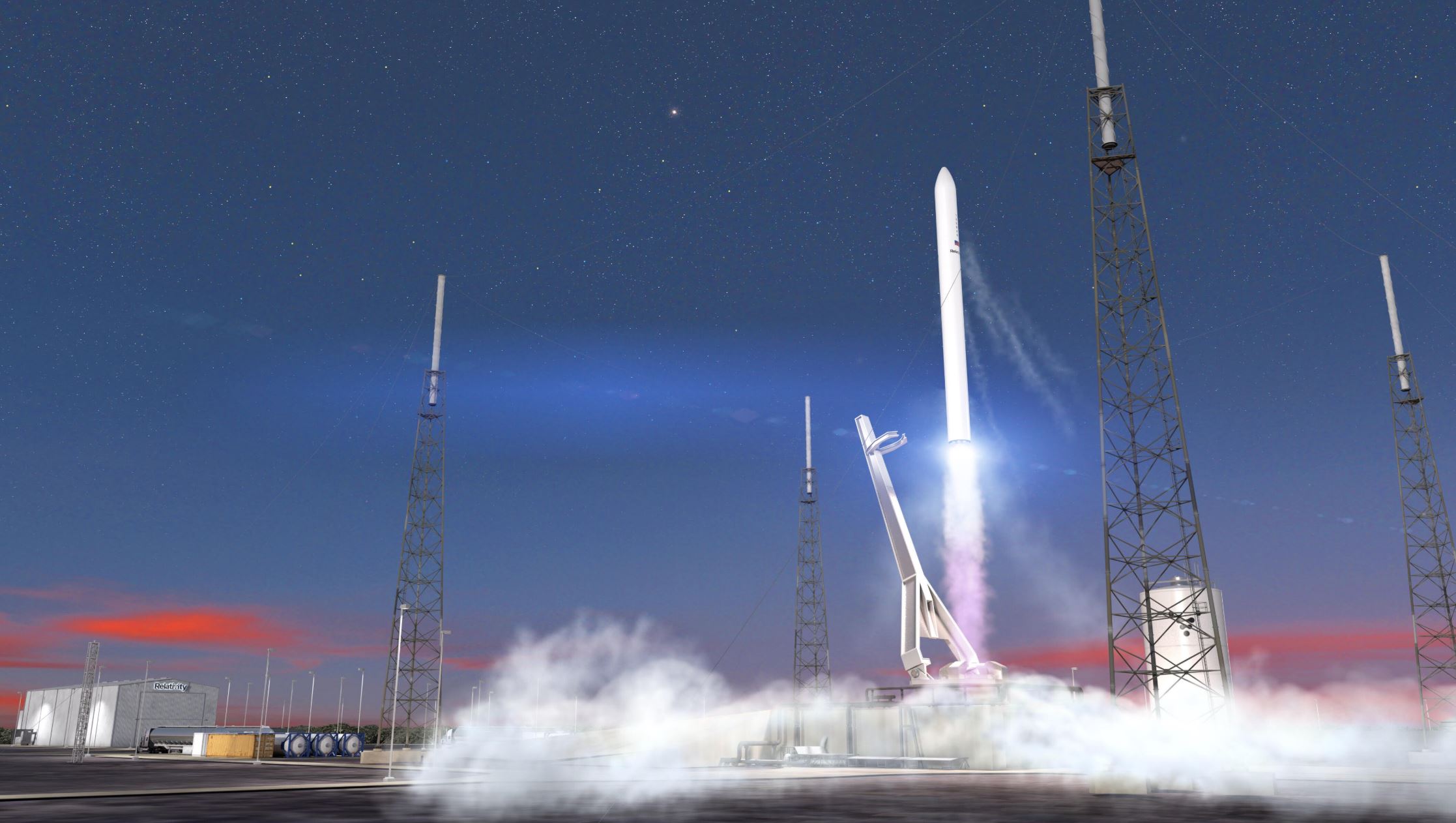Relativity Space readies for its first launch of 3D-printed rocket later this year
The Los Angeles-based startup has big plans.

Could Relativity Space be the next SpaceX?
As the Los Angeles-based startup plans to launch its 3D-printed Terran 1 rocket late this year, key market indicators show a company growing so quickly that it's attracting massive investor attention.
The company's debut launch was originally slated for 2020, but preparations now appear to be going smoothly after that initial delay, with some important milestones coming up soon.
Related: Relativity Space will 3D-print rockets at new autonomous factory
"We’re keeping the momentum strong in #2021 with hotfire testing of our development second stage! Up next: Fully-integrated stage testing of the orbital flight article, to kick off later this year!" Relativity Space said via Twitter on Jan. 21.
Hiring is also proceeding quickly, particularly on the propulsion team, the company added earlier this month.
Money is flowing in to support these efforts, too. In November, Relativity Space announced it had closed a $500 million "Series D" financing round even as the coronavirus pandemic affected similar manufacturers in the space industry. A November CNBC report pegged Relativity's market value at $2.3 billion, among the highest in the private space industry. The leader, SpaceX, was worth an estimated $44 billion last year following its own recent fundraising efforts.
Get the Space.com Newsletter
Breaking space news, the latest updates on rocket launches, skywatching events and more!
Relativity already had enough cash in the bank to send Terran 1 into space before the recent financing round and will use the new money for ventures such as a "factory of the future," along with investing more in 3D printing and launch vehicle tech, Relativity representatives said at the time.
"The last six months have been an exciting time at Relativity Space," Tim Ellis, the company's CEO, told Space.com. "We've hit a number of audacious milestones, from securing key public-private partnerships and contracts, to growing our world-class team to over 260 employees, to making huge strides in our 3D printing technology and autonomous manufacturing as we march towards launching the world's first entirely 3D-printed rocket."
Relativity closed out its busy 2020 by scoring a contract with prominent launch integrator TriSept, which in December signed on to sell capacity to its own customers for an entire Terran 1 booster in 2022. More contract details were not disclosed (including the value), but TriSept's confidence in Relativity is notable given that TriSept's current customers include NASA, the U.S. Department of Defense and the National Reconnaissance Office.
For a startup space company, receiving both hefty financing and a name-brand customer win within weeks of each other — with the customer money allowing it to "bootstrap" part of the rocket development — is huge. And Relativity has snagged other deals in recent months as well, including a deal with Iridium for six dedicated launches.
Along with the Series D financing and TriSept and Iridium contracts, another key milestone was receiving $3 million from NASA to place tiny cubesats into low Earth orbit under the agency's Venture Class Launch Services (VCLS) Demonstration 2 program. In a December press release, NASA said VCLS would "demonstrate a launch capability for smaller payloads that NASA anticipates it will require on a recurring basis for future science missions."
Related: Relativity Space to launch satellite 'tugs' on 3D-printed rocket
Space publications have taken note of Relativity's swift progress. "Is the company for real?" read the headline of a March 2020 Ars Technica story, describing the fairytale story of a company that in a few short years quickly progressed from receiving a huge check from "Shark Tank" presenter and Dallas Mavericks owner Mark Cuban, to being accepted into the prestigious Y Combinator startup group, to bounding through four rounds of financing while developing their technology.
Ars Technica also noted the inherent challenges of launching the world's first 3D-printed rocket, including whether the technology will work, how quickly the company can iterate and if 3D printing will indeed be cheaper (in the long run) than manufacturing rocket components the traditional way. But what is working in Relativity's favor is the company's deep experience despite its youth — key company execs have worked at big names such as SpaceX — and the amount of military and government interest in the technology that will help spur development during the high-cost early stages.
The larger economic uncertainty caused by the pandemic is an issue for Relativity Space, as it is for pretty much every company. Ellis noted that the pandemic has had some effect on Relativity, but the company remains focused on protecting everyone's safety while remaining as productive as possible. For example, the company has a dedicated COVID-19 task force to ensure support for employees.
"Our proprietary 3D-printing technology and use of autonomous manufacturing and robotics has uniquely positioned us to continue to make forward progress on Terran 1, even during the pandemic," Ellis added.
3D printing allows the company to produce its rockets in house without waiting for a third party's participation, while the autonomous manufacturing and robotics reduce the number of people on the floor even before taking social distancing into account.
Relativity thus has a busy 2021 ahead as the company seeks to enter a crowded launch market. But 3D printing's potential could eventually take the company beyond Earth orbit, as NASA and international entities target the moon for long-term missions later in the 2020s. NASA's Commercial Launch Services Program plans to create a commercial ecosystem on and around the moon to assist with astronauts, who the agency hopes to land on the lunar surface around 2024. Another more distant possibility could be Mars, where NASA hopes to send humans in the 2030s.
Follow Elizabeth Howell on Twitter @howellspace. Follow us on Twitter @Spacedotcom and on Facebook.
Join our Space Forums to keep talking space on the latest missions, night sky and more! And if you have a news tip, correction or comment, let us know at: community@space.com.

Elizabeth Howell (she/her), Ph.D., was a staff writer in the spaceflight channel between 2022 and 2024 specializing in Canadian space news. She was contributing writer for Space.com for 10 years from 2012 to 2024. Elizabeth's reporting includes multiple exclusives with the White House, leading world coverage about a lost-and-found space tomato on the International Space Station, witnessing five human spaceflight launches on two continents, flying parabolic, working inside a spacesuit, and participating in a simulated Mars mission. Her latest book, "Why Am I Taller?" (ECW Press, 2022) is co-written with astronaut Dave Williams.









